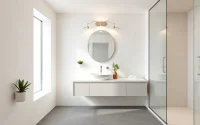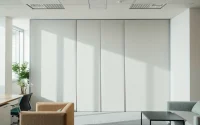Mastering Interior Painting: Techniques and Tips for a Flawless Finish
Understanding Interior Painting Basics
What is Interior Painting?
Interior painting is the process of applying paint to various surfaces within a building. This includes walls, ceilings, moldings, doors, and windows. Interior painting not only adds aesthetic value to a space but also protects surfaces from wear and damage. It’s an essential part of home maintenance and renovation that can transform a dull area into a vibrant and inviting environment. The best interior painting not only enhances the beauty of your room but also reflects your personal style and improves the overall ambiance.
Essential Tools and Materials
Before diving into any painting project, it’s vital to gather the necessary tools and materials. The right tools can drastically improve both the efficiency and quality of a paint job. Here’s a comprehensive list:
- Paint: Choose high-quality paint suitable for the surface you’re working on. Options include latex, oil-based, and specialty paints.
- Paintbrushes: Different brushes are designed for various tasks. A wide brush is ideal for large areas, while angled brushes work well for edges and trim.
- Rollers: Rollers provide a quick way to cover large surfaces and are available in various nap lengths to suit different textures.
- Drop Cloths: Protect your floors and furniture from spills and splatters with sturdy drop cloths.
- Painter’s Tape: This helps create clean edges and protect areas you don’t want painted.
- Paint Sprayer: Ideal for larger projects or achieving a smooth finish.
- Extension Pole: For reaching high walls and ceilings without the need for a ladder.
- Paint Tray and Liners: Essential for holding paint for your rollers.
- Cleaning Supplies: Rags, brushes, and solvents for cleaning brushes and spills.
Choosing the Right Paint Types
Choosing the correct type of paint can significantly influence the final result of your interior painting project. Here are some main categories to consider:
- Latex Paint: Water-based paints are easy to clean up, dry quickly, and are less odorous. Ideal for most interior walls.
- Oil-Based Paint: These paints provide a durable finish and are best for trim and moldings but have longer drying times and stronger odors.
- Specialty Paints: Options like chalk paint or textured paint can create unique finishes that add character to your space.
- Eco-Friendly Paints: Look for low or no-VOC (volatile organic compounds) options to ensure healthier indoor air quality.
Planning Your Interior Painting Project
Assessing Your Space
Before painting, it’s essential to thoroughly assess the space you plan to work on. Consider the following:
- Wall Condition: Check for cracks, holes, or peeling paint. Proper preparation of the surface will yield better results.
- Lighting: Natural and artificial lighting affect how paint colors appear. Evaluate how light shifts throughout the day in your space.
- Adjacent Spaces: Consider how the new colors will harmonize with adjacent rooms.
Preparing Your Room for Painting
Preparation is critical for a successful paint job. Here’s a step-by-step guide:
- Move furniture away from walls and cover them with drop cloths.
- Remove or tape over hardware, fixtures, and outlet covers.
- Patching holes and repairing any damage to the walls with spackle or joint compound.
- Sand walls lightly to ensure a smooth surface for the paint to adhere.
- Clean the walls to remove dust and debris.
Creating a Color Palette
Your chosen color palette can set the mood and tone of each room. Start by considering:
- Room Function: Choose colors that align with the purpose of the room—soft, neutral tones for bedrooms and more vibrant colors for playrooms.
- Style and Decor: Factor in existing furniture, fabrics, and finishes in your space.
- Color Psychology: Understand how colors can influence emotions and energies. For example, blue is calm while yellow is energizing.
Techniques for Effective Interior Painting
Brush vs. Roller: Which Should You Use?
Both brushes and rollers have their specific applications, and choosing the right one can improve your painting results. Here’s a quick comparison:
- Brushes: Best for detailed work, edges, and touch-ups. Use them for trim, corners, and intricate designs.
- Rollers: Perfect for covering broad areas quickly. Excellent for larger walls and ceilings, depending on the nap of the roller.
Applying Paint: Tips and Tricks
To achieve a flawless finish, consider these tips while applying paint:
- Start with a Primer: A primer provides better adhesion for the paint and can improve the final color vibrancy.
- The Right Technique: Use a “W” or “M” pattern when rolling for even coverage.
- Maintain a Wet Edge: Avoid lap marks by applying paint in sections and blending wet paint into wet paint.
- Thin Coats: Apply multiple thin coats instead of one thick coat for better results.
Finishing Touches: Trimming and Touch-ups
After applying paint, finishing touches can make a big difference:
- Inspect for Missed Spots: Check baseboards and corners for any areas missed during the first pass.
- Remove Painter’s Tape: Take off tape while the paint is still slightly tacky to avoid peeling.
- Final Clean-Up: Clean brushes and tools immediately after use for future projects.
Common Challenges in Interior Painting
Handling Paint Odor and Cleanup
Paint odors can be disruptive, especially in enclosed spaces. Here are some solutions:
- Ventilate the area by opening windows and using fans to circulate air.
- Utilize air purifiers or odor-absorbing charcoal bags to reduce unpleasant smells.
- Consider using low-odor paints, which are specifically designed to minimize scents.
Dealing with Paint Drips and Mistakes
Even the best painters encounter mistakes. Here’s how to manage common issues:
- Drips and Runs: Sand down drips once they are completely dry and repaint the area.
- Color Errors: If you find a color isn’t what you expected, you can always paint over it with your original intended color (after it dries).
- Cleaning Up: Keep a damp cloth handy while painting for immediate cleanup of small accidents.
Weather Considerations Affecting Interior Painting
While interior painting is less affected by weather than exterior work, humidity can still play a role:
- Humidity Levels: High humidity can slow drying times, while extremely low humidity can lead to paint drying too quickly.
- Temperature: Ideally, paint should be applied when temperatures are between 50°F to 85°F for optimal application.
Hiring a Professional for Interior Painting
When to Consider Professional Help
While many homeowners choose to tackle painting projects themselves, there are situations where professional help is advisable:
- Large Spaces: For extensive areas or multiple rooms, professionals can save time and ensure consistency.
- Specialized Techniques: If you want to employ techniques like faux finishes, consulting experts is beneficial.
- Complex Repairs: If your walls require significant prep work or repairs, experts can address issues more effectively.
Evaluating Painter Qualifications and Costs
When deciding on hiring a professional painter, consider these factors:
- Experience: Look for established professionals with a good track record.
- References and Reviews: Check online reviews and ask for references to gauge customer satisfaction. Websites like Angi or Yelp can provide insights.
- Cost Estimates: Most professional painters will provide a free estimate. Always get multiple quotes to ensure you’re getting a fair price.
Reviewing Past Projects and Customer Feedback
Before hiring, thoroughly review the painter’s portfolio and feedback from previous clients. This can provide valuable insights into their work quality and professionalism. Ask questions about:
- Timeliness and punctuality on previous jobs.
- Quality control measures they employ during projects.
- Final client satisfaction and any follow-up services they offer.


